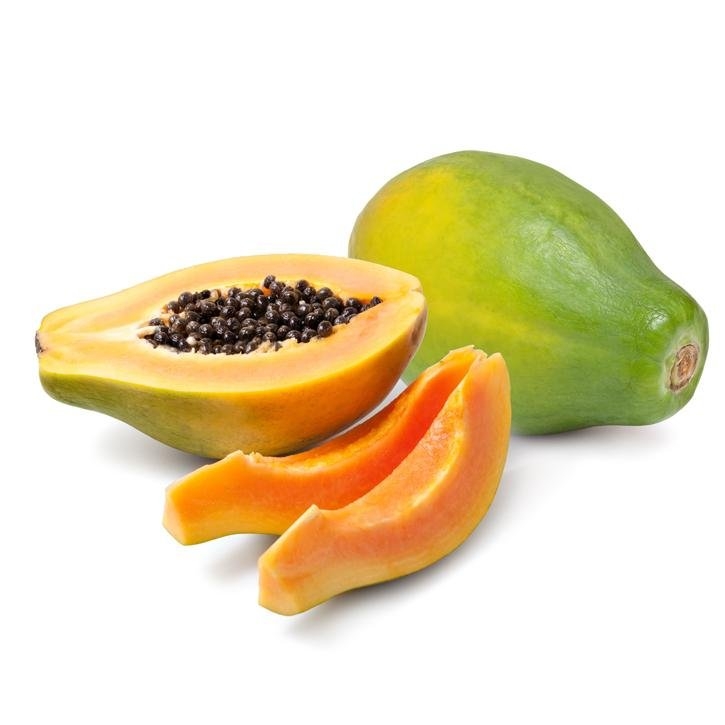This fruit is oval or sphere-shaped, of 10-20 cm long, fleshy and globose. It’s usually shaped in 5 angles of variable size and is orange when ripe. The flesh is orange-yellow with small black seeds clustered in the center, flat and covered with a transparent, gelatinous aril, connected to the flesh by a white and fibrous tissue with a fleshy endosperm. Fruits from female plants are smooth, round, large, with plenty of seed and a pentagonal mark at the base of the fruit. Fruits that come from hermaphrodite are ellipse-shaped or elongated with grooves at the surface and a mark at the base. They are smaller and have less pulp, less amount of seeds and the flavor is less intense than those from female flowers. Male plants sometimes produce fruits, but these are not normally good for commercial use. The skin is soft and has a milky white fluid (latex) that rapidly dries at the moment of fruit maturation. Then latex gradually disappears. It belongs to the Caricaceae family.
Papaya is a tropical fruit used since ancient times for its excellent digestive properties. Papaya leaves wrapped around meat make a great tenderizer. It lives in warm, semi-warm and semi-arid weather. It grows in orchards and is associated with evergreen and semi-evergreen; perennial and sub-perennial rain forests, mountain forests of pine and oak trees. Moist and heat are essential conditions for this plant development.
Internal use
External use
- Plantas Medicinales. Margarita Fernandez y Ana Nieto. Ed Universidad de Navarra. EUNSA 1982.
- Matière Médicale. RR Paris- H. Moyse. Masson 1981.
- Guía de Campo de las Flores de Europa. Oleg Polunin. Ediciones Omega S.A. Barcelona, 1977.
- Guía de las Plantas Medicinales. Paul Schauenberg y Ferdinand Paris. Ediciones Omega S.A.
- El gran libro de las Plantas Medicinales. Editorial Everest. S.A.
- Plantes Médicinales des Régions Tempérées. L. Bézanger-Beauquene, Pinkas, Torck, Trotin.
- Plantas Medicinales. Thérapeutique-Toxicité. Christiane Vigneau. Masson, Paris 1985.
- Fitoterapia: Vademecum de Prescripción. Plantas Medicinales. Colaboran: Asociación española de médicos naturistas. Colegio Oficial de Farmacéuticos de Vizcaya.
- Pharmacognosy, Phytochemistry, Medicinal Plants. Jean Bruneton. Lavoisier Publishing.
- Plantas Medicinales. El Dioscórides Renovado. Pio Font Quer.
- Pharmacopée Française IX Édition.
- Farmacognosia 2ª Edición. Jean Bruneton. Ediciones Acribia S.A. 2001.
- Bulletin officiel Nº 90/22 bis. Ministère des Affaires Sociales et de la Solidarité.
- French Public Health Code.
- Bross B. Plantas y sus aceites esenciales. Ed. Omega, 1994.
- Martindale. The extra Pharmacopoeia 29th Edition. The Pharmaceutical Press 1989.
- The Complete German Commission E Monographs. Therapeutic Guide To Herbal Medicines. Mark Blumenthal. American Botanical Council 1998.
- Pharmacognosy, Phytochemistry, Medicinal Plants. Jean Bruneton. Lavoisier Publishing.
- Database Management Unit of the National Germplasm Resources Laboratory, Plant Sciences Institute (PSI), Beltsville Agricultural Research Center, Agricultural Research Service, U.S. Department of Agriculture.
- Samuelsson, G. Drugs of Natural Origin. A Textbook of Pharmacognosy. Stockholm: Swedish Pharmaceutical Press, 1992.
- James, A; Duke, Ph D. Handbook of Medicinal Herbs. 5ª. Boca Ratón, Florida: CRC Press, 1987, pp.100-1; 518; 551.
